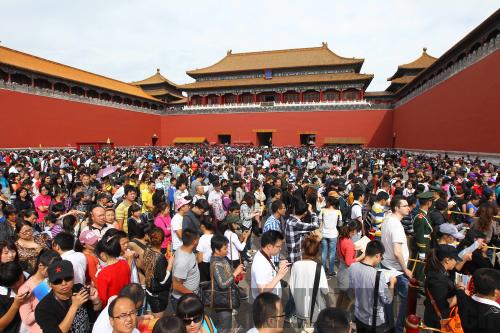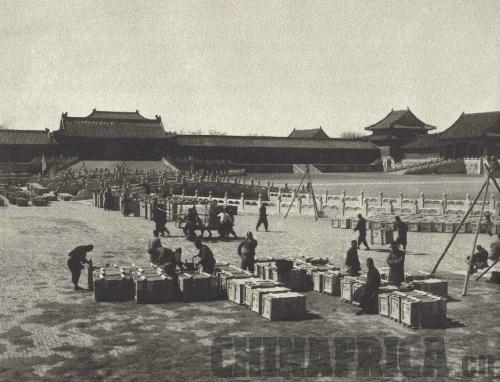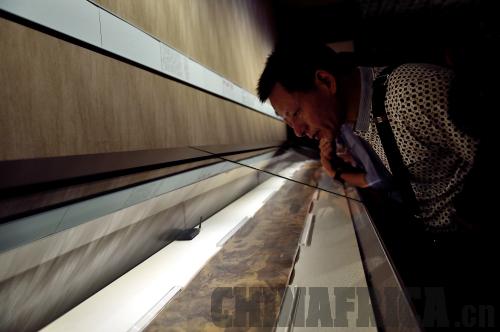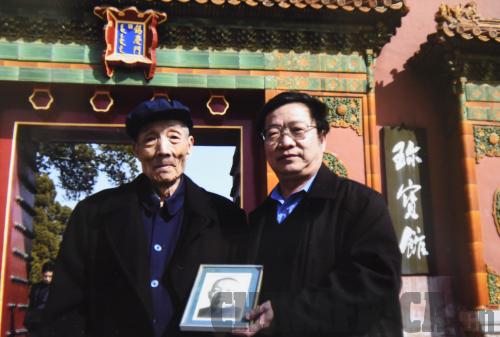| 
Visitors crowd the Palace Museum

Crates containing artifacts from the Palace Museum are packed and prepared for the move to Nanjing in Jiangsu Province in 1933

A visitor looks at the painting Along the River During Qingming Festival in the Palace Museum on September 8

Liang Jinsheng (right), Director of the Collection Management Department at the Palace Museum, poses with his father, holding a photo of his grandfather. All three generations have worked for the Palace Museum
Yu Jian, a 35-year-old businessman from Zhengzhou, capital of central China's Henan Province, came all the way to Beijing on October 10 in the hope of visiting an exhibition of ancient calligraphy and paintings at the famed Palace Museum. The journey, three and a half hours by express train, was especially to view Along the River During Qingming Festival, a painting by Zhang Zeduan during the Northern Song Dynasty (960-1127) on a scroll longer than 5 meters.
Yu had yearned to see the masterpiece for years but the last time it was shown to the public - 10 years ago - he was young and didn't get detailed information about that exhibition. So this time he was determined not to miss his chance.
Sea of people
The Palace Museum opens at 8:30 a.m. Yu arrived at the gate before 9 a.m. on October 11 only to be told by the museum staff that he would have to wait for at least 10 hours in the queue to see the famous painting.
Obviously, Yu's goal was the goal of countless others too. "I thought I was early but the line already stretched from the entrance all the way down to Wuying Hall, where the painting was on display, several hundred meters away from the gate," he said.
Compared to the other visitors, whose vigil had begun at 4 a.m., Yu was tardy. Xu Xiaolu, a sophomore from Beijing Normal University, arrived at the gate around 5:30 a.m. to find many people already waiting.
"I knew what the situation would be like because some of them shared pictures of the long queue online," Xu said. "I had got up at 4:30 a.m., but still it seemed I was late."
The exhibition that attracted the sea of viewers was a display of masterpieces from the Precious Collection of the Stone Moat, a catalogue of calligraphy and paintings owned by royals of the Qing Dynasty (1644-1911). It was opened on September 8 as part of the celebrations for the 90th anniversary of the Palace Museum.
The objects d'art had been amassed during the reign of emperors Qianlong (1736-1796) and Jiaqing (1796-1821) by a team of 31 officials. They accumulated more than 10,000 of the finest paintings and calligraphy works. From this precious collection over 100 pieces were chosen for the Palace Museum's 90th anniversary display.
"It is such a great opportunity to have so many treasures displayed together," Zeng Jun, Director of the Palace Museum's calligraphy department, said when the exhibition was inaugurated. "Along the River During Qingming Festival, the highlight of the exhibition, will be shown for one month. After this, people won't be able to see it again for at least three years."
It is a painting which portrays daily life in the city of Bianjing (modern-day Kaifeng in Henan) with detailed portraiture of people from all walks of life. The bustling scene is testimony to Bianjing's prosperity. Because of the historical and cultural value of the painting and the artist's mastery, even copies can fetch millions of yuan.
Along with the paintings and calligraphy, items from the Ru kiln, one of the five most famous kilns of China, were also on display. The kiln produced exquisite blue, glazed porcelain objects exclusively for the use of Song royals.
"The Song Dynasty is my favorite dynasty in China's history," said Zhang Yi, a movie maker, who visited the exhibition. "It is the dynasty for the arts. I want to make a movie about this dynasty as well as the awesome porcelain."
The enthusiasm for Along the River During Qingming Festival far exceeded Zeng's expectations. "It was not the first time the masterpiece was on display at the Palace Museum," he said. "We had also exhibited it on the 80th anniversary of the museum but there were fewer visitors at that time."
There has been a sharp rise in the number of visitors in recent years. Seven million people visited the Palace Museum in 2002. In 2014, their number more than doubled to 15.34 million. In the past, October 1, 2005 saw a record number of visitors - over 56,100. On October 2, 2012, more than 182,000 visitors swarmed the museum's halls, setting the highest record ever.
The visitor numbers have become so high that the museum has to control admissions now. Since 2014, it remains closed on Mondays for renovation and maintenance work, and since June 13 this year, visitors have been limited to 80,000 daily. On October 2, the 80,000 tickets were sold out shortly after the doors opened, and all the ticket windows shut down at 10:10 a.m.
Piece of history
The Palace Museum is housed in the Forbidden City, the palace of royals from the Ming Dynasty (1368-1644) to the end of the Qing Dynasty (1644-1911), in downtown Beijing. In 1987, the Forbidden City was included in the UNESCO's World Cultural Heritage list.
As home to most Ming emperors and all Qing emperors, the Forbidden City witnessed royal family intrigue and turmoil from 1420 to 1911. Following the Revolution of 1911, which ended the Qing reign, the last emperor, Puyi, remained in the complex until 1924.
After Puyi was expelled, a special committee was formed by the government in 1925 to catalog the artifacts in the Forbidden City. On October 10, the Palace Museum was established, surviving wars and social unrest in the subsequent years.
From 1933 to 1945, during China's War of Resistance Against Japanese Aggression, the majority of the artifacts - 19,600 crates of treasures - travelled all over the country, from Beijing to Nanjing in Jiangsu Province and then to other safe places further inland.
In 1948 and 1949, nearly 3,000 crates were taken to Taiwan by the fugitive Kuomintang Party led by Chiang Kai-shek. In 1965, the National Palace Museum was built in Taiwan, resulting in the existence of two Palace Museums today.
Liang Tingwei was part of the team protecting the collection during the war and his entire family went with him to all the places where the artifacts were taken for safekeeping. In 1949, Liang went to Taiwan. His family broke up when his grandson Liang Jinsheng, who was one year old at that time, came back to Beijing with his father.
Liang Tingwei passed away in Taiwan in 1972. In 2008, his son, the last person to witness the odyssey of the relics, died too.
Liang Jinsheng spent his childhood mostly in the Palace Museum, where his father worked, collecting artifacts geographically scattered by war.
In 1979, Liang Jinsheng also started to work in the museum. Today, he is director of the collection management department.
"It is an honor to follow in the footsteps of the older generations," Liang Jinsheng said. "My grandfather transferred national treasures out of Beijing while my father was responsible for bringing them back. Now, I am in charge of putting them in order."
Windows to the future
In 2004, Zheng Xinmiao, curator of the museum between 2002 and 2012, began the long process of curating and arranging the items sequentially. After more than six years, thousands of artifacts have been sorted out.
The 1,807,558 items include paintings, works of calligraphy, copper exhibits, ancient books and documents, porcelain objects and 11,000 sculptures, some of which date back to the Warring States Period (475-221 B.C.)
It's an overwhelming amount of history. "If we display 18,000 items each year, we'll still need 100 years to show all the items," said Shan Jixiang, the present curator.
On October 11, four new sections were opened to visitors, making 65 percent of the complex accessible to the public.
"In 2002, only 30 percent of the Forbidden City was open," Shan said. "In 2014, it expanded to 52 percent. In 2020, on the 600th anniversary of the Forbidden City, we will open more than 80 percent of the complex."
Shan said many visitors still regard the Palace Museum as a tourist destination, especially with the rising popularity of recent TV soaps on the lives of ancient royalty in the Forbidden City.
"These plays are fictitious," Shan said. "Museums are more for education. I hope in the future our museum will show the real picture of life here in the past."
Shan, appointed in early 2012, has worn out more than 20 pairs of traditional cloth shoes supervising the 9,000 rooms of the Forbidden City. He runs a tight ship. "We have taken thousands of photos," he said. "Whenever we find something wrong, we show the pictures to the staff. It has made them much more alert."
To modernize the time-honored Palace Museum and increase its appeal, especially to the young, Shan has taken new initiatives, such as the museum's mobile app. It displays the museum's exhibits in 3D.
An account of the Palace Museum, titled Micro Palace Museum, was launched on social networking app WeChat in 2012. It provides information on exhibitions and introduces masterpieces with cartoons.
An online shop, registered in 2010 on leading shopping website Taobao.com, sells souvenirs, including images of ancient princes and princesses.
"Integrity is the key to a sustainable and fascinating museum," Shan said. "I hope we can maintain [this] museum's integrity for another 90 years."
|